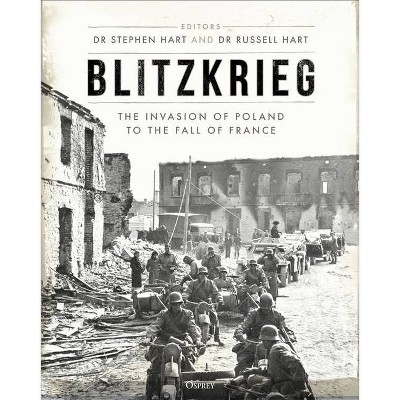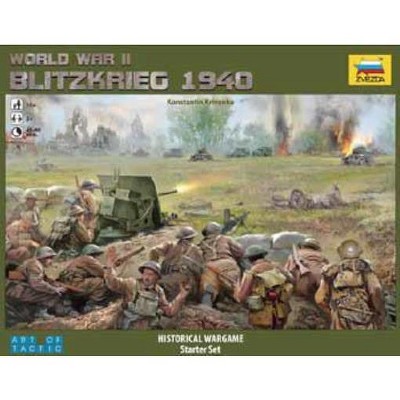Blitzkrieg - (Hardcover)

Similar Products
Products of same category from the store
AllProduct info
<p/><br></br><p><b> About the Book </b></p></br></br><b>A fascinating study of the</b><b> devastating new form of warfare that redrew the map of Europe </b><b>in the opening year</b><b> of </b><b>World War II</b><b>, bringing about the military collapse of three modern</b><b> industrialized</b><b> armies.</b><p/><br></br><p><b> Book Synopsis </b></p></br></br><p><b>A fascinating study of the</b><b> devastating new form of warfare that redrew the map of Europe </b><b>in the opening year </b><b>of </b><b>World War II</b><b>, bringing about the military collapse of three modern</b><b> industrialized</b><b> armies. </b> <p/>On 1 September 1939, Nazi Germany launched the invasion of Poland, employing a new type of offensive warfare: Blitzkrieg. Based on speed, maneuverability, and concentration of firepower, the strategy saw startling success as the panzer divisions, supported by Stuka dive-bombers spread terror and mayhem, reaching Warsaw in just one week; the campaign was over by early October. This was followed by Operation <i>Weserübung, </i>the invasion of Denmark and then Norway in 1940, the first joint air-sea-land campaign in the history of warfare. <p/>Even more striking an achievement was the swift and conclusive defeat of France in 1940. Refusing to let its forces dash themselves against the fortifications of the Maginot Line, Germany instead sent its divisions through neutral Belgium and northern France, destroying Allied resistance and pursuing the remnant of the British and French forces to Dunkirk in an audacious and devastatingly effective assault. <p/>Though the dominance of the Blitzkrieg method was to be challenged in the latter part of the war, as Allied forces found methods of disrupting the attacks and dominating the battlefields, its unparalleled success in the early years of the conflict brought Europe to its knees. <p/>Illustrated throughout with detailed maps and contemporary photographs, <i>Blitzkrieg: The Invasion of Poland to the Fall of France</i> tells the story of these first breakneck attacks, analyzing the technology, planning, and execution as well as the challenges faced by the Germans in the pursuit of this new and deadly form of warfare.</p><p/><br></br><p><b> Review Quotes </b></p></br></br><br>This is an expertly written volume on the initial stages of World War II. -<i>Military Archive Research</i><br><p/><br></br><p><b> About the Author </b></p></br></br><p>Dr. Russell A. Hart is Professor of History and Director of the Diplomacy and Military Studies Program at Hawai'i Pacific University, Honolulu, Hawai'i. He is the author of<i> Clash of Arms </i>(2001) and <i>Guderian: Panzer Pioneer or Mythmaker?</i> (2006). He has co-authored nine additional books, including three Osprey titles: <i>The Second World War, Part Six: Northwest Europe, 1944-1945 (2002); The Second World War: A World in Flames (2004), </i> and<i> The Second World War (2018). </i>He lives in Kailua, Oahu, Hawaii. <p/>Dr. Stephen A. Hart is senior lecturer in the War Studies department, the Royal Military Academy Sandhurst. Prior to this he lectured in the International Studies Department at the University of Surrey, and in the War Studies Department, King's College London. He is the author of <i>Montgomery and the 'Colossal Cracks': The 21st Army Group in Northwest Europe 1944</i><i>-</i><i>45</i> (Praeger, 2000), and has co-authored--with Russell Hart--several popular histories of aspects of the German Army in World War II.</p>
Price History
Price Archive shows prices from various stores, lets you see history and find the cheapest. There is no actual sale on the website. For all support, inquiry and suggestion messagescommunication@pricearchive.us
![Blitzkrieg [LP] - VINYL](https://pisces.bbystatic.com/image2/BestBuy_US/images/products/2168/21682718_sa.jpg)



![Blitzkrieg: Escape from Stalag 69 [DVD] [2008]](https://pisces.bbystatic.com/image2/BestBuy_US/images/products/3463/34634281_so.jpg)


![Blitzkrieg: Escape From Stalag 69/The Blood Ape [DVD]](https://pisces.bbystatic.com/image2/BestBuy_US/images/products/3514/35144543_so.jpg)
![Blitzkrieg: Escape from Stalag 69 [DVD/VHS] [DVD] [2008]](https://pisces.bbystatic.com/image2/BestBuy_US/images/products/2185/21853022_so.jpg)










